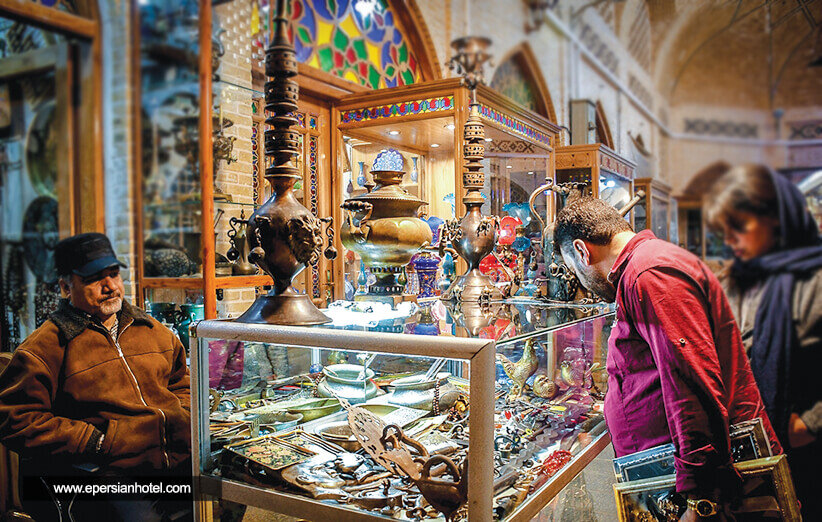From trade to tradition: a journey through iconic bazaars

TEHRAN – For tourists, Iranian bazaars offer a window into local culture, providing opportunities to witness authentic social interactions and procure unique Iranian souvenirs.
They offer a mixture of colors, sounds, and aromas that enrich the travel experience. It's safe to say that no visit to Iran would be complete without exploring at least a few of its iconic bazaars.
Bazaars have long been integral to the fabric of Iranian cities, often situated near prominent places of worship.
While primarily centers of trade, they transcend their commercial function to become vibrant social institutions, and people from all walks of life converge.
With the advent of Islam, bazaars gained added significance, evolving to incorporate educational, religious, and communal facilities such as schools, Tekiehs for Islamic ceremonies, Hammams (public bathhouses), and caravanserais. These additions catered to the diverse needs of merchants, residents, and travelers, underscoring the bazaar's pivotal role in economic stability and societal cohesion.
Throughout history, bazaaris have wielded considerable political influence, their collective voice resonating in pivotal events like the Constitutional Revolution, the nationalization of Iranian oil, and the 1979 Islamic Revolution.
The country is home to thousands of bazaars, each city boasting its own unique marketplace alongside bustling daily markets. Here are glimpses of ten traditional bazaars in Iran:
Qeysarieh bazaar
When there’s any talk of bazaars in Isfahan, many think of a bazaar surrounding the UNESCO-registered Naqsh-e Jahan Square.
If you want to ditch the touristy souvenir shops and get better prices, taking a stroll within Isfahan’s Qeysarieh bazaar is a must.
Bazaar-e Tajrish
Bazaar-e Tajrish, named after an old neighborhood, where it is located in northern Tehran, has become rather popular with tourists in the past few years.
But still, many prefer a visit to the Grand Bazaar of Tehran instead. While Tajrish is definitely not as big as the Grand Bazaar, it offers a very unique experience.
The most significant part of Tajrish bazaar is dedicated to food. And unlike most bazaars in Iran, it doesn’t just offer spices and nuts but a whole variety of fresh ingredients.
The variety of fruits and vegetables here is even a surprise for the locals. From the craziest tropical fruits to specific wild herbs, you’ll find it all here. It’s open every day of the week but gets super crowded before Nowruz, the Persian New Year.
Carpet Bazaar of Tehran
The Grand Bazaar of Tehran has lost some of its authenticity throughout recent years and it’s mostly dominated by China-made products.
The carpets section of the Grand Bazaar, however, is another story. There’s a huge three-story section dedicated to all kinds of handwoven nomadic rugs, carpets, kilims, and pictorial rugs.
Bazaar-e Tabriz
Tabriz is the best example of Islamic bazaar in Iran. It’s the biggest roofed bazaar in the world perfectly known for its Timcheh Mozafarieh where the most intricate carpets are sold. The bazaar of Tabriz is the biggest in Iran and it’s recognized as a UNESCO world heritage.
You could easily spend a whole day wandering through its alleyways. It’s also relatively easy to get lost in. And apart from great shopping, there are plenty of local restaurants and mosques to be found within the bazaar.
Darvazeh-Kazerun market
Darvazeh-Kazerun is rarely known to foreign tourists. It’s the first market in Shiraz dedicated to fresh food and where many of the locals buy their fruits and vegetables. ّ
There’s also a beautiful but tiny mosque situated at the end of the market where you’ll see many sellers heading during prayer times.
Anything from fresh veggies and fruits to nuts, tea, and bread is to be found in the bazaar. There’s also an amazing fish market located right next to it.
Goldsmiths’ Bazaar of Yazd
Goldsmiths’ Bazaar of Yazd (locally known as Bazaar-e Zargarha) is a small section of the famous Bazaar-e Khan in the UNESCO-registered city and probably a favorite spot among local women.
In Yazd, where all types of jewelry are created into various forms and shapes using molding, metal casting, and wax removal, the art of goldsmithing and creating jewels has a long history.
Yazdi goldsmiths have long been renowned for their unique artistic talent, impeccable taste, and patience when creating jewelry.
Bazaar-e Vakil
Anything from silverware to antiques, carpets, and handicrafts can be found in Bazaar-e Vakil located in downtown Shiraz.
The bazaar is not too big and you easily visit it in a few hours without getting lost. Many travelogues have mentioned sections of the bazaar dedicated to spices and carpets.
Fish market of Bandar Abbas
If you happen to be in Bandar Abbas on your way to visit Qeshm or Hormuz islands, then a stop at the local fish market is a must.
There are all kinds of fresh fish and other sea creatures to be found here. There are also a few locals outside the bazaar who would be willing to cook the fish for you at a fair price.
Bazaar-e Rasht
Rasht is without a doubt a favorite Persian food destination in northern Iran.
It’s no wonder that its bazaar is probably among the most delicious food bazaars in the country. There’s everything from seafood to tea and fresh veggies but my absolute favorite part is the long array of pickles and olives.
Bazaar-e Ganj Ali Khan
Ganj Ali Khan Bazaar in Kerman is part of a great complex of the same name that includes an impressive mosque, one of the best-preserved hammams, a school, and a caravanserai.
While wandering around the bazaar keep an eye on the intricate plasterwork and watch out for creepy mannequins.
AM
Leave a Comment